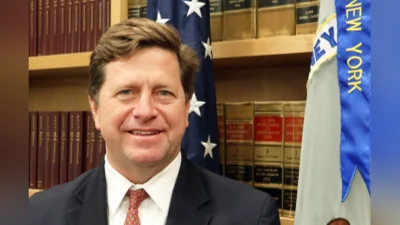The Congressional Record is a unique source of public documentation. It started in 1873, documenting nearly all the major and minor policies being discussed and debated.
“EQUAL OPPORTUNITY ACT” mentioning the U.S. Dept of Labor was published in the House of Representatives section on pages H5282-H5285 on May 16, 1996.
The publication is reproduced in full below:
EQUAL OPPORTUNITY ACT
The SPEAKER pro tempore (Mr. Skeen). Under the Speaker's announced policy of May 12, 1995, the gentleman from Florida [Mr. Canady] is recognized for 60 minutes.
Mr. CANADY of Florida. Mr. Speaker, this evening I rise to address the Equal Opportunity Act, legislation which Senator Dole and I introduced on July 27 of last year.
This legislation will, if enacted, end the use of race and gender preferences by the Federal Government in Federal employment, Federal contracting, and in the administration of other Federal programs.
The principles of equal treatment and nondiscrimination on which this legislation is based are principles which are at the heart of the American experience. They embody an ideal which generations of Americans have honored and sought to realize, an ideal to which we as a people have long aspired but an ideal which we have never fully attained in our life as a Nation.
On Saturday of this week, May 18, we will mark the 100th anniversary of the Supreme Court's decision in Plessy versus Ferguson, the decision which represents the culmination of disappointment in the struggle for equality before the law during the 19th century.
In Plessy by a 7-1 majority, the Supreme Court of the United States held that Louisiana's law requiring railroads to provide racially separate accommodations did not violate either the 13th or the 14 amendments. Justice Henry Billings Brown, in delivery the court's opinion, explained the difference between a distinction based on race and prohibited discrimination.
He said as follows:
A statute which implies merely a legal distinction between the white and colored races has no tendency to destroy the legal equality of the two races or to reestablish a state of involuntary servitude.
Brown went on to observe that in the nature of things, the 14th Amendment could not have been intended to abolish distinctions based upon color. According to Brown, the 14th Amendment challenged in Plessy reduces itself to the question of whether the statute of Louisiana is a reasonable regulation.
Brown then concluded:
We cannot say that a law which authorizes or even requires the separation of the races is unreasonable.
This is a shameful decision. And although the segregationist doctrine embodied in Plessy has been rejected by the courts most strikingly in Brown versus Board of Education, the case itself has never been directly overruled. Indeed, the core holding of Plessy that Government may make distinctions in the treatment of its citizens based on their race remains the law of our land.
Justice Harlan's dissent in Plessy, which, is recognized as the most famous dissent in the history of American jurisprudence, has been vindicated by history but the principles so eloquently articulated in that dissent has not finally been accepted by the courts. In words that would often be cited by those seeking to overthrow the Jim Crow system, Justice Harland pronounced:
Our Constitution is colorblind. The law regards man as man and takes no account of his surroundings or of his color when his civil rights, as guaranteed by the supreme law of the land, are involved.
Harlan found a Louisiana statute unconstitutional because the Constitution of the United States does not permit any public authority to know the race of those entitled to be protected in the enjoyment of their civil rights.
Simply put, Government may not have regard to the race of its citizens when the civil rights of those citizens are involved.
The color-blind ideal was the touchstone of the American civil rights movement until the mid 1960's. In 1947, Thurgood Marshall, representing the NAACP Legal Defense and Educational Fund in a brief for a black student denied admission to the segregated University of Oklahoma Law School, stated that principle unequivocally. Classifications and distinctions based on race or color have no moral or legal validity in our society. They are contrary to our Constitution and laws.
{time} 1945
Marshall's support for the color-blind principle, which he later, unfortunately, abandoned, is vividly revealed by Constance Baker Motley, senior United States district judge for the southern district of New York, in an account included in Tinsley Yarborough's biography of Justice Harlan. Judge Motley recalled her days working with Marshall at the NAACP as follows:
Marshall had a Bible, to which he turned during his most depressed moments. Marshall would read aloud passages from Harlan's amazing dissent. I do not believe we ever filed a major brief in the pre-Brown days in which a portion of that opinion was not quoted. Marshall's favorite quotation was our Constitution is color-blind. It became our basic creed.
Marshall admired the courage of Harlan more than any justice who had ever sat on the Supreme Court. Even Chief Justice Earl Warren's forthright and moving decision for the court in Brown did not affect Marshall in the same way. Earl Warren was writing for a unanimous Supreme Court. Harlan was a solitary and lonely figure writing for posterity.
In the face of the vociferous opposition to the Equal Opportunity Act, and any other proposal to end the use of preferences, we would do well to remember the long battle that was fought to establish a legal order based on the principles set forth in justice Harlan's dissent.
Professor Andrew Carl, in his admirable history ``The Color Blind Constitution,'' identifies the centrality of the color-blind principle to the civil rights movement. Professor Carl says as follows:
The undeniable fact is that over a period of some 125 years, ending only in the late 1960s, the American civil rights movement first elaborated then held as its unvarying political objective a rule of law requiring the color-blind treatment of individuals.
In 1964, the U.S. Congress took a great stride forward toward the realization of that objective. With the passage of the Civil Rights Act of 1964, the Congress established a national policy against discrimination based on race and sex.
It is the supreme irony of the modern civil rights movement that this crowning achievement was so soon followed by the creation of a system of preferences based on race and gender, a system contrived first by administrative agencies and the Federal courts and then accepted and expanded by the Congress.
The 1964 Civil Rights Act constituted an unequivocal statement that Americans should be treated as individuals and not as members of racial or gender groups; an unequivocal statement that no American should be subject to discrimination, which Senator Hubert Humphrey, the chief sponsor in the Senate of this legislation, defined as a distinction in treatment given to different individuals because of their difference race.
Yet the ink was hardly dry on the 1964 law when a process of transformation began and the system of preferences was erected piece by piece. This took place not because Congress had failed to express its intention clearly, but because of a court system and an administrative structure determined to pursue their own purposes despite the clearly expressed purpose of the Congress.
Since the issue of imposing quotas and granting preferences based on race to compensate for historical wrongs had been the subject of controversy during the year preceding congressional consideration of the 1964 act, Congress was careful to directly address the issue in the text of the law itself.
Section 703(j) of the act stated that nothing in Title VII of the act shall be interpreted to require any employer to grant preferential treatment to any individual or to any group because of the race of such individual or group in order to maintain a racial balance.
The managers of Title VII, Senator Clark of Pennsylvania, and Senator Case of New Jersey had submitted a joint memorandum on the subject where they stated, and I quote:
Any deliberate attempt to maintain a racial balance, whatever such a balance may be, would involve a violation of Title VII because maintaining such a balance would require an employer to hire or refuse to hire on the basis of race. It must be emphasized that discrimination is prohibited to any individual.
It is, I think, impossible to imagine a clearer more unambiguous statement of congressional intent on the subject of racial preferences. But in the face of this directly expressed purpose in the law, the bureaucracy and the courts decided to chart their own course. In the place of the principles of individual rights, equal opportunity and nondiscrimination, which were embodied in the 1964 Civil Rights Act, the courts and the bureaucracy moved forward with the establishment of a system based on the concepts of proportional representation, group entitlement, and guaranteed results. This approach was foreshadowed by Judge John Miner Wisdom of the fifth circuit in United States versus Jefferson County, where he upheld school desegregation guidelines promulgated by the Office of Education under Title VI of the 1964 act and stated, and again I quote.
The Constitution, according to Judge Wisdom, is both color-blind and color conscious. The criterion is the relevancy of color to a legitimate governmental purpose.
This is, indeed, a far cry from the clear principles articulated by Justice Harlan and doggedly pursued by the civil rights movement throughout most of its history.
The concepts of proportional representation, group entitlement and guaranteed results found full-blown expression in the Nixon administration's Labor Department order No. 4, which was first issued in November of 1969 and was aimed at the activities of all Federal contractors.
The order stated the rate of minority applicants recruited should approximate or equal the rate of minorities to the applicant population in each location.
This was clearly a mandate for proportional representation. A more direct conflict with the provision of 703(j) of the 1964 Civil Rights Act would be impossible to devise.
After a minor flack over order number 4, a revised order was issued by the Labor Department in February 1970. No substantive changes were made. The revised order number 4 provided that the affirmative action programs adopted by contractors must include goals and timetable to which the contractor's good faith efforts must be directed to correct deficiencies in the utilization of minority groups.
This construct of goals and timetables to ensure the proper utilization of minority groups clearly envisioned a system of proportional representation in which group identity would be a factor, often the decisive factor, in hiring decisions. Distinctions in treatment would be made on the basis of race.
The concept of proportional representation embodied in order number 4 not only defied the intent of section 703(j) of the 1964 Civil Rights Act, but also contravened the express nondiscrimination provisions of the Executive Order it was issued to implement. That is the Executive Order requiring affirmative action.
The course was set by the bureaucracy and the courts did little to interfere. With few exceptions, until the Supreme Court decided the Adarand case last year, the color-blind ideal was an eclipse. Year after year the system of preferences granted or imposed by the Federal Government grew with the active support of the Congress itself.
The dominant attitude was captured in 1978 in the opinion of Justice Blackmun in the Bakke case, which dealt with a California medical school's policy of preferential admissions for minority students. Justice Blackmun distilled the rationale for preferential policies. He said, and I quote, ``in order to get beyond racism, we must first take account of race. In order to treat some persons equally, we must treat them differently.''
In the face of the provision of title VI of the 1964 Civil Rights Act, that no person in the United States shall, on the ground of race, color or national origin be excluded from participation in, be denied the benefits of, or be subjected to discrimination under any program or activity receiving Federal financial assistance, the closely divided court in Bakke recognized that race could at least be a factor in determining eligibility for admission to an educational institution receiving Federal financial assistance.
The system of preferences is based on the notion that we can only overcome our history of discrimination by practicing discrimination. To guarantee the equitable apportionment of opportunities, Americans must be divided, sorted and classified by race and gender. It is the responsibility of government not to create a level playing field for all Americans, but to determine outcomes based on race and gender. Rather than dealing with its citizens as unique individuals who are equal in the eyes of the law, the Government of the United States must treat everyone as group members, as people whose biological characteristics determine the scope of their claims on our government.
The Equal Opportunity Act rejects this vision of America. It would overturn the status quo of race and gender preferences and return to the principles on which the Civil Rights Act of 1964 was based. In place of group rights, it would establish respect for individual rights.
It is very important to focus on the specific provisions of the Equal Opportunity Act. Simply stated this legislation would prohibit the Federal Government from intentionally discriminating against or granting a preference to any person or group based in whole or in part on race, color, national origin or sex in three areas: Federal contracting, Federal employment, and the administration of other federally conducted programs or activities.
In addition, it would prevent the Federal Government from requiring or encouraging Federal contractors or the recipients of Federal financial assistance to discriminate or grant preferences based on race or sex.
Let me elaborate on a few key points. First, the bill applies only to Federal programs and activities. It, therefore, does not affect programs or policies administered by State and local governments, the private sector, or colleges and universities.
Second, the Equal Opportunity Act does not affect our comprehensive regime of anti-discrimination laws. All forms of racial and sex-based discrimination that are illegal under current law would remain so under the Equal Opportunity Act.
In addition, all remedies currently available to individuals who have been discriminated against will remain completely unaffected by this bill. Though you will hear claims to the contrary, it is simply not the case that this bill weakens, undermines or otherwise affects laws that make it illegal to discriminate on the basis of race and sex.
Third, the bill draws an important distinction between preferential treatment and affirmative action. Preferential treatment is prohibited and affirmative action, as originally conceived, is permitted and expressly protected.
I think we all recognize that the term affirmative action has come to describe a whole range of measures, from casting a wider net at the recruiting and outreach stage to outright quotas, setasides and other numerical preferences.
Section 3 of the Equal Opportunity Act expressly provides that the government may continue affirmative action in the form of vigorous outreach and recruitment efforts. Steps taken to increase the size of the applicant pool for a contracting or employment opportunity, including steps targeted specifically at women and minorities, are permissible so long as at the decision stage all applicants are judged in a nondiscriminatory manner; that is, without regard to their race or sex.
If the bill does not affect anti-discrimination laws or nonpreferential forms of affirmative action, then what does it do? It would, in short, put an end to all Federal programs that will require the Government to take into account the race or sex of American citizens and to treat them differently based on what group they belong to.
There is frustrating unwillingness on the part of many people to acknowledge what we all know; namely that there are many, many such programs and policies currently being administered by the Federal Government: Contracting setasides and bid preferences, grant programs targeted solely at women and minorities, and hiring and personnel systems that are driven by numerical goals and timetables. These are all preference programs that, on their face, discriminate on the basis of race and sex, and these are the programs that would be eliminated under the Equal Opportunity Act.
{time} 2000
The heart of the Equal Opportunity Act is found in its definition of preference. The bill as recently passed by the Subcommittee on the Constitution defines the term preference as an advantage of any kind, including a quota, set-aside, numerical goal, timetable, or other numerical objective. This functional definition makes clear that it is not what we call a policy, a practice, or a program that determines its appropriateness.
The test is how that policy, practice, or program actually operates. If the policy, practice, or program gives an advantage of any kind to individuals because of their race or gender, it is unlawful. Those who oppose the Equal Opportunity Act have the burden of explaining why anyone should receive an advantage of any kind based on race or gender.
The supporters of preferences realize that this burden is indeed a heavy one. They understand that the American people are opposed to the system of preferential treatment that has been erected over the years since 1964. They know the power of the principles of equal treatment and nondiscrimination. They know that Americans have an instinctive respect for individual rights.
The defenders of the status quo of preferential treatment have chosen not to meet this challenge. They have decided that a principled defense of group rights and proportional representation would not be successful, since it is so clearly at odds with values that are central to the American experience. So rather than attempting such a principle defense of preferences, they have launched a campaign of confusion and distortion.
Mr. Speaker, the recent barrage against the Equal Opportunity Act is just the most recent phase of the long-standing effort to conceal the realities of the preferential system from the American people. I can cite many examples of the distortions used to defend the status quo and to attack the Equal Opportunity Act. But the remarks delivered by President Clinton at the National Archives on July 19, 1995, the President's famous ``mend it, don't end it'' speech, stands as the epitome of distortions in defense of the status quo of preferences.
The President's speech is indeed a handy compendium of the rhetorical devices used to obscure the issues and to mislead the American people. The core of the President's speech is found in the four so-called standards of fairness for affirmative action programs. The President summarized these standards as follows, and I quote:
No quotas in theory or practice, no illegal discrimination of any kind, including reverse discrimination, no preference for people who are not qualified for any job or other opportunity.
And as soon as the program has succeeded, it must be retired. Any program that does not meet these four principles must be eliminated or reformed to meet them.
This statement by the President represents an attempt to redescribe and redefine reality. In it, words are stripped of their ordinary, commonly understood meaning and infused with a new meaning. When the President says he is against quotas, he signals his recognition that the American people are against quotas, and that some other terminology must be used to describe the system of perferances based on race and gender, a system which apportions benefits based on group membership. But when the President denounces quotas, he fails to explain how a quota is different from a set-aside under which contract opportunities are reserved for members of a particular race or gender group. And he does not explain how a system of goals and timetables under which race and gender determine who receives a job and who does not receive a job, is any less unjust than a system of quotas under which race and gender determine who receives a job and who does not receive a job.
When the President says no preferences for the unqualified, he conveniently glosses over the fact that individuals who are more qualified are systemically denied jobs and other opportunities solely because they belong to the wrong racial or gender group.
When the President says that, as soon as a program has succeeded, it must be retired, he fails to specify the standard of success and he fails to tell us when exactly when we can expect these supposedly temporary programs to end.
When the President says we should have no illegal discrimination of any kind, he fails to explain how the system of counting by race and gender can be reconciled with either the letter or the spirit of the Civil Rights Act of 1964. The President and the other defenders of preferential policies have constructed a fictitious world, a world where discrimination pure and simple is given another name and called just.
The Equal Opportunity Act rejects that fictitious world. It rejects the false descriptions of the programs, policies and practices of the Federal Government which have been foisted on the American people by the defenders of the status quo. The Equal Opportunity Act is based on an understanding of the flaws of the system of preferences based on race and gender. It is based on a realistic evaluation of the way that system operates and the injustice for which it is responsible.
It recognizes that the system of preferences unfairly places burdens on and denies opportunities to those who have been guilty of no wrongdoing. Simply because of their race or gender, while granting benefits to individuals who are not victims of discriminatory conduct, it recognizes that the system of preferences is by its very nature discriminatory and morally wrong.
The Equal Opportunity Act is based on an understanding that the existence of the system of race and gender preferences unfairly casts a cloud over the accomplishments of individuals who are members of favored groups and deprives those individuals, the individuals the system is supposed to benefit, of the full measure of respect they are due for their individual achievements.
Mr. Speaker, finally, and most importantly, the Equal Opportunity Act is based on the recognition that the system of race and gender preferences sends a message from government to the American people that we should think along racial and gender lines, a message which only reinforces prejudice and discrimination in our society.
As long as the Federal Government is engaged in the business of classifying and sorting the American people into racial and gender groups, can we really expect to reach the goal of a society free of prejudice and discrimination? It has been 100 years since Justice Harlan spoke so eloquently of the color-blind Constitution. Since that time, we have made much progress in reducing prejudice and discrimination in America. But we are far, far from the goal of a society in which individuals are treated as individuals and where irrelevant biological characteristics are treated as irrelevant.
As we mark the 100th anniversary of the shameful Plessy decision, we should turn our attention again to the principles so forcefully stated by Justice Harlan in his renowned dissent. Those principles find expression here in this Congress in the Equal Opportunity Act.
Mr. Speaker, it is time that we reaffirm the principles of equality before the law and nondiscrimination. We can do so clearly and unequivocally by passing the Equal Opportunity Act and ending the odious system of race and gender preferences established by the Federal Government. We can recognize once and for all that each American has the right to be treated by our government, not as a member of a particular race or gender group, but as an individual American citizen, equal in the eyes of the law.
____________________








